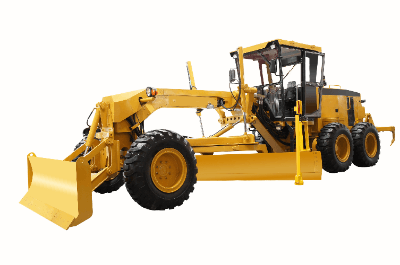What Is a Grader?

A grader, also known as a motor grader, is a construction machine used for tasks such as leveling roadbeds and pavements in construction sites and road construction, as well as for snow removal operations.
Equipped with a blade of 3.1m to 4.3m in width mounted at the bottom center of the machine, its angle and height can be adjusted to perform delicate and precise leveling operations. A grader that is self-propelled by an engine is referred to as a motor grader, and those used for snow removal operations are known as snow graders.
In addition to the blade, graders can be equipped with various working attachments such as a snow plow, ripper, and scarifier. They are indispensable construction machines in large-scale construction sites and snow removal operations.
Uses of Grader
Graders are primarily used for leveling large construction sites, leveling roadbeds and pavements in road construction, and preparing the subgrade for asphalt paving. They are mainly employed for spreading and leveling work. The blade, raised in a bank-up position, can also be used for tasks like cutting slopes.
While bulldozers also perform leveling work, they are suited for different locations and purposes. Bulldozers are suitable for leveling large amounts of soil and soft ground, whereas graders are used for precise leveling tasks such as road construction, where high accuracy is required.
In large construction sites, it is common to use bulldozers for rough leveling followed by graders for finishing leveling. Moreover, graders are employed as snow removal machines in regions with snowfall.
Principles of Grader
Similar to other construction machines, graders operate using hydraulic power. Operators adjust the height and tilt of the blade by manipulating multiple levers in the control cabin. Presently, graders are available with joystick controls, eliminating the need for a steering wheel.
Structure of a Grader
The grader has a structure with a long boom extending forward, equipped with a blade (moldboard) suspended from it. The rear section contains the operator’s cabin and houses the engine. The tire configuration is 6 wheels on 3 axles, with 2 wheels at the front and 4 wheels at the rear.
While the blade is angled for operations, it generates a reactive force when under load. To prevent the front wheels from swaying and ensure a straight path, there is a leaning mechanism that tilts the front wheels left and right, maintaining straight-line stability.
How to choose a Grader
When selecting a grader, one considers the intended use, choosing based on blade width and engine output. For earthmoving, a grader with a blade width of 3.1m to 3.7m is used, while for snow removal, the standard is a grader with a blade width of 3.7m to 4.3m. Graders have a much smaller lineup compared to other construction machines.
Other information on Grader
1. Types of Attachments
In addition to the blade, various working attachments such as a snow plow, ripper, and scarifier are available. These attachments enable a wide range of operations.
Snow Plow
Attached to the front of the machine, it is used for deep new snow and snowdrift removal. There are angling plows that can adjust the discharge direction to the left or right and V-plows that can discharge snow to the left or right.
Ripper
Attached to the rear of the machine, it is a large-toothed attachment used to crush the ground or rock.
Scarifier
Attached to the center of the machine, it is a wedge-shaped attachment used for crushing and excavating hard ground.
2. License Required for Driving
While graders are used for tasks such as leveling land on roads and construction sites, a large special license is required to drive them on public roads. Moreover, for operational use, according to the Labor Standards Act, a qualification as a vehicle-related construction machinery operator is necessary. Both a driving license and qualification are required for grader operation.